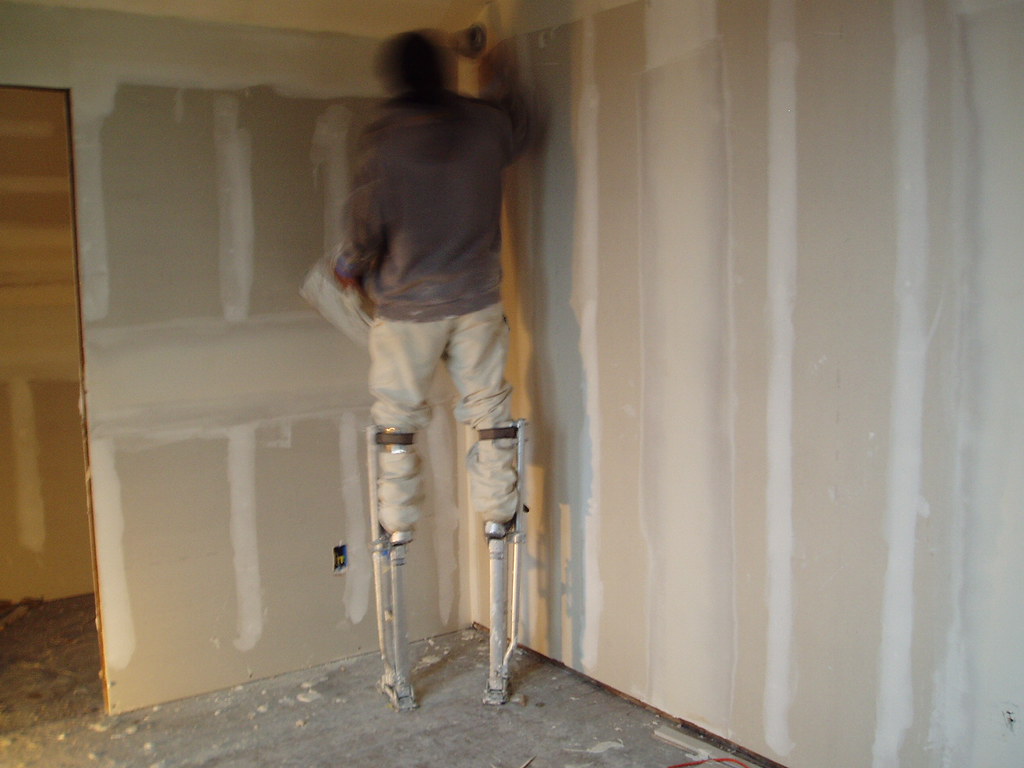Discover how plastering stilts can revolutionize your workflow and dramatically boost efficiency on tall walls and ceilings – but only if you know these crucial facts first.
Understanding Plastering Stilts: The Basics
Plastering stilts have become an essential tool in modern construction, offering plasterers a reliable way to reach high areas without constant ladder repositioning. These specialised elevation tools typically offer adjustable heights ranging from 15 to 40 inches, making them versatile for various ceiling heights and wall applications. Leading brands like SurPro and Marshalltown dominate the UK market, offering professional-grade models equipped with advanced features such as dual-action springs for smooth movement and padded Velcro straps for enhanced comfort and stability. Modern stilts incorporate lightweight aluminium construction, non-slip rubber soles, and adjustable leg bands that distribute weight evenly for extended use.
The Compelling Benefits of Plastering Stilts
The advantages of using plastering stilts extend far beyond simple height access. Professional plasterers report up to 40% increased efficiency when working on ceiling projects, primarily due to the elimination of constant ladder repositioning. The continuous workflow enabled by stilts allows for more consistent application and better finishing results. Additionally, users experience significantly reduced physical strain on their lower back and knees compared to traditional methods, as the need for repetitive climbing is eliminated. Recent studies indicate that plasterers using stilts can cover up to 30% more surface area per day compared to those using conventional access methods.
- Dramatically improved reach and mobility while working at height
- Reduced setup time compared to scaffolding or platform systems
- Better consistency in application due to maintained working position
- Decreased physical fatigue from repetitive ladder climbing
- Enhanced productivity with fewer work interruptions
Key Considerations Before Purchasing
Before investing in plastering stilts, several crucial factors demand careful consideration. First, assess your physical fitness level – while stilts have become more user-friendly, they still require good balance and core strength. Consider your typical workload; stilts are most cost-effective for professionals regularly working on projects involving high walls or ceilings. The learning curve can be significant, with most users requiring 15-20 hours of practice to achieve comfortable proficiency. Learning proper plastering techniques is essential for success.
- Physical requirements: Good balance, core strength, and overall fitness
- Project suitability: Frequency of ceiling and high wall work
- Workplace regulations: Compliance with HSE guidelines
- Storage and transport considerations
- Insurance implications and safety certifications
Safety and Best Practices
Safety should be your paramount concern when using plastering stilts. According to HSE statistics, proper training reduces stilt-related incidents by 75%. Essential safety protocols include proper strap adjustment, regular equipment inspection, and maintaining clean, obstacle-free work areas. Modern stilts feature dual-action springs and reinforced leg bands that significantly enhance stability, but users must still follow strict safety guidelines.
- Always work with a spotter during initial training periods
- Maintain clear, dry work surfaces free from debris
- Regularly inspect all straps, springs, and attachment points
- Never exceed the manufacturer’s recommended weight limits
- Wear appropriate safety gear, including non-slip boots
Cost Analysis: Investment vs. Returns
Quality plastering stilts typically range from £200 to £500, with premium models offering enhanced durability and comfort features. While this initial investment might seem substantial, the potential returns are significant. Professional plasterers report earning back their investment within 2-3 months through increased productivity and the ability to take on more projects. Maintenance costs are relatively low, with replacement parts like straps and rubber soles available for £20-40 annually. Consider that traditional access equipment like towers or scaffolding can cost significantly more over time, both in terms of purchase/rental and setup time.
Alternative Solutions and Comparisons
While plastering stilts offer numerous advantages, it’s worth considering alternative solutions. Traditional methods like ladders and hop-ups remain viable options for certain applications, particularly in restricted spaces or for short-duration tasks. Modern alternatives such as adjustable work platforms and telescopic supports have also emerged in recent years.
- Traditional ladders: Lower cost but reduced efficiency and increased physical strain
- Platform systems: More stable but time-consuming to reposition
- Telescopic supports: Good for spot work but limited range of motion
- Work tool boots: Quicker setup but height limitations
Making the Final Decision
The decision to invest in plastering stilts should be based on a careful evaluation of your specific circumstances. For professional plasterers working regularly on residential or commercial projects, stilts typically offer a strong return on investment through improved efficiency and reduced physical strain. However, occasional users or those primarily working on small-scale projects might find traditional access methods more cost-effective. Consider your project pipeline for the next 6-12 months and calculate potential time savings against the initial investment.
Expert Tips for Getting Started
If you’ve decided to invest in plastering stilts, success lies in proper selection and technique. Choose models with dual-action springs and adjustable leg bands for optimal stability. Start with lower height settings and gradually increase as your confidence grows. Many experienced users recommend practicing basic movements in an open area before attempting any actual plastering work.
- Begin with heights under 24 inches until fully comfortable
- Practice walking, turning, and maintaining balance without tools first
- Invest in quality knee and ankle supports for added stability
- Consider taking a professional training course for accelerated learning
- Always maintain three points of contact when moving
FAQ
How to put stilts on for beginners?
And then I start with my legs. First. And then do. My. Little I can’t think what it’s called strap i know it’s called strap just And then you’re going to do your feet. Do them pretty tight.
Sources
[1] https://stilts.com
[2] https://www.youtube.com/watch?v=iqd7_flUuf8
[3] https://www.youtube.com/watch?v=qhY09TuWfbw

